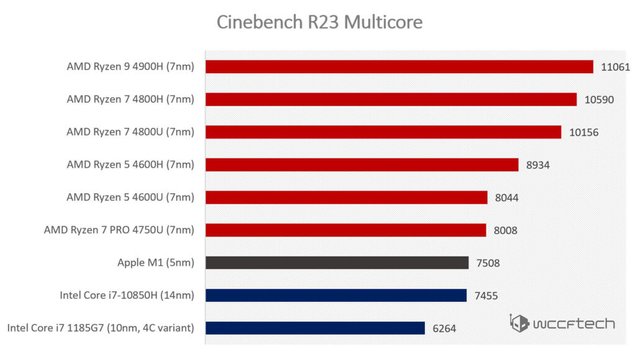
Since its presentation in the November 2020 keynote - which has been covered in detail in a previous article - the new Apple M1 SoC has catalyzed the attention of media and tech enthusiasts. Being the first specimen of its new generation and representing the pinnacle of a decade worth of development efforts by Cupertino's finest engineers, M1 has triggered very high expectations while at the same time sparking quite a controversy. This double-sided stance was fueled by Apple's presentation, which put forth strong claims about its capabilities and at the same time lacked any form of objective comparison or direct reference to support them. A few weeks have passed since, media outlets have reviewed the first three Macintosh powered by the new chip, and it's time to see if Apple's original statements checked out.
Benchmarks versus real world
Before actual reviews were available, benchmark results were published that indicated Apple's claims of very high performance were possibly correct: scores from the popular GeekBench 5 test suite confirmed that Apple M1 has a strong single-core performance which also reflects into good multi-core performance.
As explained in the previous article, however, GeekBench (like many other similar tools) is a synthetic benchmark whose results are by definition designed to be compared but do not necessarily relate in any meaningful way to real-world performance. As explained by Jay Conrod,
Because of the way benchmarks are used, it is crucial that they accurately reflect real-world performance so that optimizations actually improve user experience.
It is worth noting that GeekBench does not run its tests for an extended time, meaning it can potentially hide performance loss caused by thermal throttling in the long term; this is a very common occurrence in real-world usage. Moreover, GeekBench calculates its score using a geometric mean, which is the correct way to handle normalized data but can skew the results if algorithm-specific optimizations are present on an architecture; notably, Apple takes pride and openly admits that "the foundations of Big Sur are optimized to unlock the power of M1, including developer technologies from Metal for graphics to Core ML for machine learning". GeekBench 5 runs natively on M1, hence taking advantage of specific optimizations.
Some websites even reached a certain level of ridiculousness by boasting that M1 "destroyed" the former top score in AnTuTu, which is a mobile benchmark: by doing that, they are expressing excitement about a laptop being faster than a mobile phone - which is a meaningless comparison.
Actual performance of Apple M1
Several early tests have promptly confirmed one of Apple's presentation claims, showing that a Macintosh with the M1 chip was faster than all Intel-based Macs.

This, however, has conveniently left out any comparison with non-Apple computers running on Intel and AMD processors.
What has emerged from testing, reviews, and hands-on experiences is that Apple Silicon (thanks to its integrated architecture and 5-nanometer process) is more efficient than x86 chips, meaning it dissipates less heat for the same performance; but it also has a low TDP, meaning that x86 chips in comparison consume more energy and get warmer, but are still faster and complete the same workload in the same time or less.
More efficiency translates to longer battery life, but with a low TDP design (like M1) that does not mean raw speed; in other words, M1 is faster than x86 chips that are using the same power, but whenever necessary the x86 chips will ramp-up power and complete the job faster.
What this means is that, as expected, Intel and AMD mobile CPUs are actually crushing the M1 in real-world apps like Cinebench R23:

These results are even more interesting as AMD Ryzen CPUs are scoring better than the 5nm-based M1 despite being based on the older (less efficient) 7nm production process. Intel's 14nm Core i7-10850H gets the same score, and the 10nm variant scores just 1000 points less compared to the Apple M1 despite having 4 cores instead of 8. (source: wccftech)
The much-vaunted GPU performance of M1 ("The world’s fastest integrated graphics in a personal computer" according to Apple) has also been challenged. Results indicate that M1 can perform better than the latest Intel XE integrated graphics in the GFXBench 5 Metal benchmark, which runs natively on Apple Silicon and is optimized for it, but things change when playing actual games. Running "Shadow of the Tomb Raider" at the lowest settings allows the M1 to beat an Intel XE chip (58 frames per second versus 37), but turning the graphic to high preset sees the M1 output drop to 40fps, which is handily beaten even by an entry-level GeForce GTX 1650 Ti GPU. In other words, Apple M1 integrated GPU is fast, yet not fast enough to play real games above low details nor capable to compete even with an entry-level GPU. It is, however, more than adequate for personal productivity and home use (just like Intel's integrated graphics).
These results prove not just that Apple Silicon is not "faster than 98 percent of Windows laptops", but also that - as expected - the Apple M1 is not even the fastest mobile chip around, by a very long shot.
Making sense of the results
Based on all the considerations from the previous article and above, are the new M1-powered Macintosh any good?
Setting aside for a moment all the marketing fluff and nonsensical claims about "faster than" and "better than", it is a measurable and confirmed fact that Apple M1 - even though really not the be-all and end-all of personal computing - is a very valid SoC capable of delivering solid performance for everyday use while keeping a low thermal profile and sipping power at a surprisingly low rate, which allows MacBook Air and Pro to run for extended periods between charges.
Therefore the answer, in short, is yes: the new M1 Macintosh are good enough.
That however comes at a price and includes some caveats, which will be explained in the next article.